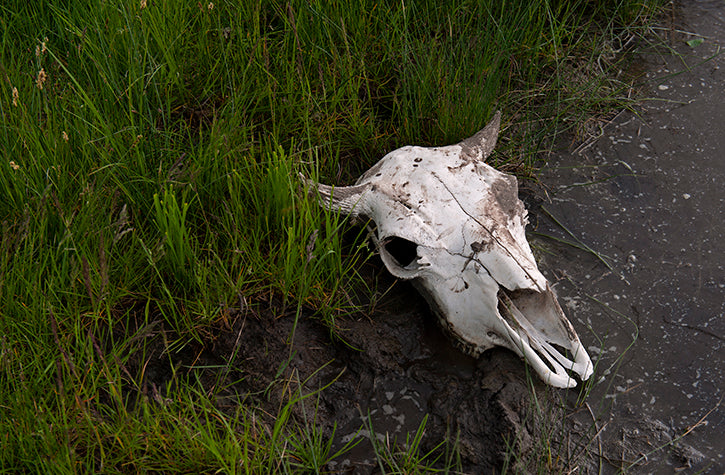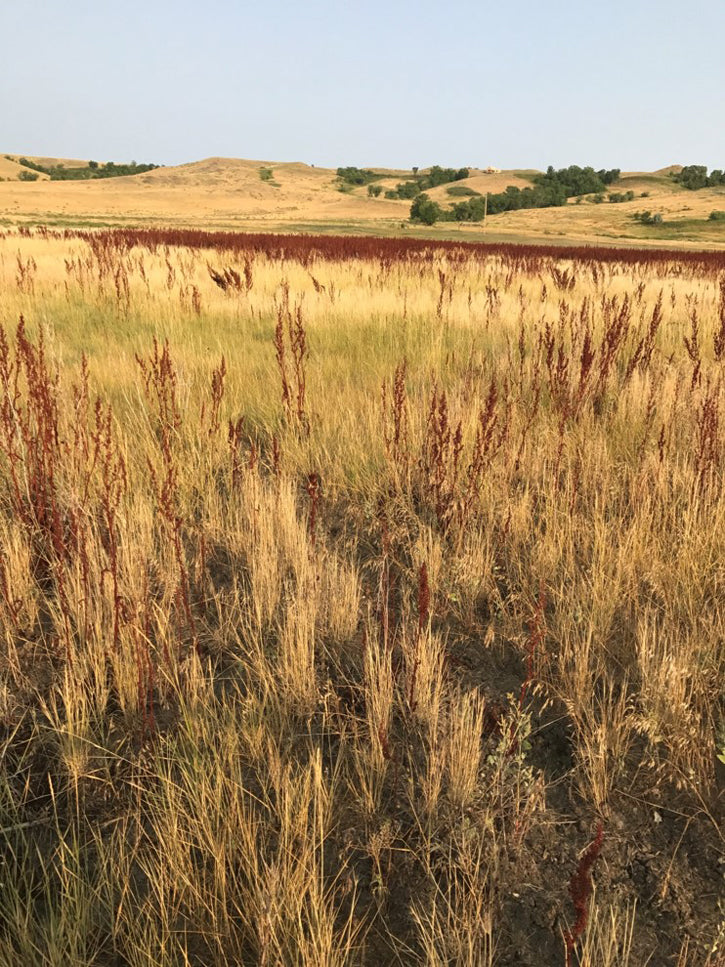Written by Colton Jones
Five years ago, the Wild Idea Cheyenne River Ranch started composting the unusable parts of the bison, returning that nutrient rich organic matter back to the earth. Colton lays out the process in his story below, which we published three years ago, but have updated with current photos. Give it a read.

Anyone who’s traveled across the Great Plains has seen the vast spaces housing various forms of energy that make up native plants and fauna. Here, plants and organisms have endured hundreds of thousands of years of evolution and developed their own way to utilize the prairie’s sole source of energy, the sun.
Some members of the prairie’s ecosystem convert energy directly from the sun for their own survival, and many primary consumers such as bison have evolved to depend upon these producers; secondary consumers such as wolves depend upon the primary consumers… and so forth, until a food web has formed.
About 10% of the sun’s energy makes it into earth’s atmosphere; the rest is reflected back into space. And within this 10%, a percentage of energy is lost between every interaction occurring in the food web. There’s nothing we can do about the 90% that’s “lost,” but we can do something about the rest. And that’s important, because that 10% supplies all of the ecosystems in the world.
Disruptions in energy exchange in any ecosystem could have detrimental effects on members of its communities. For decades, industrial agriculture has manipulated the flow of energy as it travels through the Great Plains ecosystem. The result is a decrease in biodiversity, and depleted soils. For years, the Cheyenne River Ranch was a victim of this disruption. In some areas it still shows in the form invasive plants such as, Cheatgrass (a grass that arrived on ships from Eurasia in the mid-to-late 1800s), and bare spots that present nothing but exposed soil.
For over a decade, the Cheyenne River Ranch and other producers in alliance with Wild Idea Buffalo Co. have been working to help our little piece of prairie to again capture the energy it once enjoyed in an undisturbed state. We do this with regenerative grazing practices, pasture monitoring, and on-ranch composting.

Above photo of compost being distributed on to disturbed land taken in 2017
For the last five years, the offal and bones (what’s left over after we’ve field-dressed a carcass) from the bison harvested on the Cheyenne River Ranch has been composted and dispersed via a manure spreader. This is done in disturbed areas that show low productivity and decreased diversity from years of farming. In other words, energy that would normally be removed from the ecosystem in the industrialized meat paradigm is now being retained within the system. This energy is utilized by producers such as grasses and forbs to increase their spread and ability to capture energy from the sun.
Many areas of the ranch are far from being in an original state, but progress is evident to a trained eye: We’ve seen an overall increase in ground cover and plant life. In turn, erosion and water evaporation have decreased, and overall bio-diversity has increased.
The process is slow and requires long-term planning and patience, but the reward comes in viewing long-lost residents such as Western wheatgrass, grasshopper sparrows, pronghorn sheep and sharp-tailed grouse all in a display of symbiosis.

14 comments
Thanks for sharing this. What an incredible improvement. You and the bison are bringing the land back to life! I recently became interested in this process. Have you thought about doing on-site seminars for people interested in following in your footsteps putting to use these practices you’ve developed? I saw a video on Youtube of a man who has been using livestock to restore dried up barron land in Africa for many years. Its amazing to see how he’s transforming the land there. Your mission is so inspiring!Love the photography too!!
This is very interesting but I don’t understand the calculus. Since most of the animal is removed from the prairie and only a fraction is returned to the earth, doesn’t this mean that soil is still losing more fertility than is being returned?
Thanks for the reminder: Nature bats first.
You guys ROCK!
You are showing that disturbing an ecosystem is so easy compared to the time it takes to get it back. Forget quater financial reports and expected short term return on investment.
A right cheap way to restore pastureland, too! Seems like the spreader would get all gummed up with buffalo goody, but I’m retired from ranching so don’t know the topic firsthand.
Noteworthy work. Good use of resources and intellect.
Leslie’s restoring an old ground driven Manure spreader like yours for her horse property to spread composted stall bedding (wood shavings manure and urine} . They work great and in this case are a coopretive effort between two neighboring farms.
Restoring and reusing older equipment is also good ecology!
And funds saved are good for other projects.
Love this piece! I don’t garden so much now but when I did, I think compost was my favorite product. Any time we can improve the soil, we do the whole web a huge favor. Check out www.bio4climate.org to see many examples of others doing their best to improve soil worldwide. Lots of great videos, especially the ones on the Carbon Cowboys.
Yes, Nature bats first. Thank you, once again,
Pat
EXCELLENT!! Very good! :D Keep up the good work, it looks like you’re already getting good definite results, just from the photos! :)
But — what about the intestines (sausage skins)? The liver (yum!)? Etc.? Obviously, the other … stuff (like, what was in the intestines at the time …) could easily be plowed under, and blood and bone meal are excellent fertilizers, but it would be a shame to lose out on some of the still usable “giblets,” shall we say! :)
Also: does the Cheyenne River Ranch have a way of dealing with the hide/leather? There are several businesses out there, I’m sure, who’d be more than happy to have an arrangement to receive those! :)
Nancy
Wildlife Biologist
Thank you for the education. I particularly like how you express the sunshine in energy times and how the buffalo helps to restore this energy. Wonderful cycle!
Wow, this is fantastic!
I composted for YEARS when I had my house. Now I live in a condo and I miss it!!
Keep up the good work that you do!!